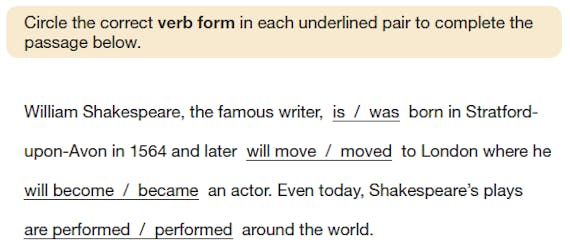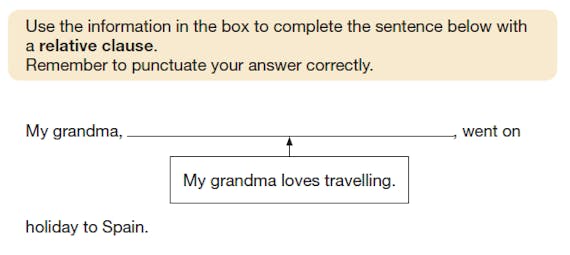KS2 SATs Grammar & Punctuation Revision - Popular Questions
Table of Contents
As with English Reading and Maths SATs questions, the curriculum, structure and format of the grammar, punctuation and spelling SATs tests remains the same every year.
Thus, several question types and topics reliably pop up every year.

Here we will talk about the grammar, punctuation and spelling SATs papers, the questions that appear year after year, and how to tackle them.
The KS2 spelling, punctuation and grammar test consists of two papers: a punctuation and grammar 'short-answer' paper and a separate spelling paper.
The following topics and question types are examples of what frequently comes up in the punctuation and grammar paper.
Verb Tense Agreement Questions
Verb tense agreement questions identify which form of a verb needs to be used depending on the tense of the sentence, i.e., whether it is past, present, or future, and what impact changing the tense can have on the meaning of the sentence.
Examples include:
- 2016 KS2 Punctuation and Grammar: 10, 26, 35, 44, 46.
- 2017 KS2 Punctuation and Grammar: 5, 30, 38, 47, 48.
- 2018 KS2 Punctuation and Grammar: 8, 12, 20, 38, 40, 49.
- 2019 KS2 Punctuation and Grammar: 24, 28, 29, 38, 39, 42.
- 2022 KS2 Punctuation and Grammar: 8, 11, 22, 29, 35, 40, 46, 49.
How to Answer Verb Tense Agreement Questions
- If the question involves choosing the correct verb tense for a sentence, read the sentence carefully.
- Look for words in the sentence which indicate the tense, i.e., has it happened in the past, is it happening now, or will it happen in the future?
- If given options, try them out in the sentence and check which makes the most sense.
- Once you have made your selection, read through the text again to check that it makes sense.
Example Verb Tense Agreement Question
Taken from 2022 KS2 Punctuation and Grammar SATs Paper, Question 11.

How to answer:
- Read each passage carefully.
- Look at the tense of each sentence, i.e., is it past, present, or future? For example, in this question, the first sentence is past tense and the second is in the present tense.
- Choose the verb form to fit with the tense. In this question, the correct selections are was, moved, became, and are performed.
- If unsure, try both options in the sentence and see which makes the most sense.
- Circle the correct words clearly – do not be tempted to circle both as you will not be given the marks unless your choice is accurate and clear.
Correct Punctuation Use Questions
Punctuation questions are enormously popular within punctuation and grammar papers. They are designed to check children's understanding of when, why, and how different types of punctuation can be used.
For example, children are often required to select a sentence which uses punctuation correctly or add punctuation to a given sentence. Questions can cover all types of punctuation, including capital letters, full stops, commas, apostrophes, brackets and dashes for parenthesis, hyphens, colons, and semi-colons.
Examples include:
- 2016 KS2 Punctuation and Grammar: 5, 6, 8, 9, 12, 16, 17, 18, 19, 20, 22, 23, 30.
- 2017 KS2 Punctuation and Grammar: 2, 3, 7, 8, 10, 12, 14, 15, 19, 21, 25, 28, 29, 36, 39, 43, 46.
- 2018 KS2 Punctuation and Grammar: 1, 2, 5, 7, 14, 16, 17, 19, 28, 30, 34, 35, 36, 41, 47.
- 2019 KS2 Punctuation and Grammar: 1, 4, 6, 10, 11, 13, 16, 20, 22, 23, 31, 34, 40, 43, 46, 48.
- 2022 KS2 Punctuation and Grammar: 4, 5, 6, 7, 9, 13, 14, 16, 20, 21, 23, 27, 41, 45, 47.
How to Answer Correct Punctuation Use Questions
- It is a good idea to revise all the different types of punctuation and their uses when revising for KS2 SATs.
- Read the questions carefully and check which type of punctuation the question is referring to.
- If choosing between sentences, look for any obvious errors to eliminate some options.
- Other than apostrophes, most punctuation is designed to create a break or pause in a sentence. Look for any natural breaks or pauses in the text, as this may indicate where punctuation may be required.
- Once you have made your selection, check your answers by reading the sentence(s) using the punctuation.
Example Correct Punctuation Use Question
Taken from 2017 KS2 Punctuation and Grammar SATs Paper, Question 39.

How to answer:
- Read the instructions carefully.
- Check which type of punctuation is required – brackets. Brackets are used for parenthesis, which separates extra information or explanation from the main sentence.
- Check the sentence for any extra information or explanation, for example, the height of the mountain.
- The sentence should make sense read aloud without the information in brackets.
- Insert brackets at the beginning and end of the extra information, i.e. (1,344 metres).
- Try reading the sentence without using the words in the brackets to check the answer. i.e. The highest mountain in Great Britain is Ben Nevis in Scotland. If the sentence makes sense without the information in the brackets, the brackets have likely been used correctly.
- The correct answer is - The highest mountain in Great Britain is Ben Nevis (1,344 metres) in Scotland.
Word Class & Grammatical Terms Questions
Word class questions usually require children to identify, select or input different types of words, such as verbs, nouns, adjectives, adverbs, prepositions, conjunctions, pronouns, and determiners.
Examples include:
- 2016 KS2 Punctuation and Grammar: 3, 4, 7, 11, 24, 28, 32, 33,36, 38, 42.
- 2017 KS2 Punctuation and Grammar: 9, 11, 13, 16, 18, 20, 33, 34, 35, 37, 42, 45.
- 2018 KS2 Punctuation and Grammar: 6, 18, 21, 22, 24, 27, 31, 33, 42, 44, 45, 48.
- 2019 KS2 Punctuation and Grammar: 8, 9, 17, 21, 27, 30, 32, 33, 35, 37, 41, 47, 49.
- 2022 KS2 Punctuation and Grammar: 1, 10, 15, 26, 30, 31, 33, 36, 37, 39, 48, 50.
How to Answer Word Class & Grammatical Terms Questions
- It is a good idea to revise the different types of word class and their uses when revising for KS2 SATs.
- Read the question carefully, and check how many words are required, i.e., if it's just one word or multiple.
- Double-check the word class that is being used.
- If identifying word class, look at the given words and how they are used in the sentence, e.g., Is it describing a noun or verb? Does it indicate where something is happening? Or is it joining clauses?
- If you need help, try and think of examples of the given type of word, this may help indicate the correct words in a sentence.
- It may help to eliminate some words, i.e., if you are looking for pronouns, you can eliminate some words as verbs, nouns, and conjunctions.
- If the question requires the addition of a type of word, try adding a word and reading the sentence as a whole; if it makes sense it is likely the correct word type.
Example Word Class & Grammatical Terms Question
Taken from 2018 KS2 Punctuation and Grammar SATs Paper, Question 31.

How to answer:
- Read the question carefully.
- Look at the underlined words, i.e., beautiful and beautifully.
- While the words seem similar, they have different functions in their sentences.
- In sentence number 1 – Josef has beautiful writing. The word beautiful is used to describe a noun (writing) and is, therefore, an adjective.
- In sentence 2 – Josef writes beautifully. The word beautifully is used to describe a verb (writes) and is, therefore, an adverb.
- Write the answers carefully in the spaces provided.
Identifying Main, Subordinate, & Relative Clauses Questions
Questions relating to a sentence's structure often require children to identify, add or name the different parts of a sentence, such as main clauses, subordinate clauses, relative clauses, noun phrases or adverbial phrases.
Examples include:
- 2016 KS2 Punctuation and Grammar: 2, 27, 29, 39, 43.
- 2017 KS2 Punctuation and Grammar: 23, 26, 32, 49.
- 2018 KS2 Punctuation and Grammar: 15, 37, 39, 43, 50.
- 2019 KS2 Punctuation and Grammar: 19, 36, 45, 50.
- 2022 KS2 Punctuation and Grammar: 19, 24, 25, 44.
How to Answer Main, Subordinate, & Relative Clauses Questions
- It is a good idea to revise the different types of word class and their uses when revising for KS2 SATs.
- Read the question carefully, and check how many words are required, i.e., if it's just one word or multiple.
- Double-check the word class that is being used.
- If identifying word class, look at the given words and how they are used in the sentence, e.g., Is it describing a noun or verb? Does it indicate where something is happening? Or is it joining clauses?
- If you need help, try and think of examples of the given type of word, this may help indicate the correct words in a sentence.
- It may help to eliminate some words, i.e., if you are looking for pronouns, you can eliminate some words as verbs, nouns, and conjunctions.
- If the question requires the addition of a type of word, try adding a word and reading the sentence as a whole; if it makes sense, it is likely the correct word type.
Example Main, Subordinate, & Relative Clauses Question
Taken from 2022 KS2 Punctuation and Grammar SATs Paper, Question 25.

How to answer:
- Read the question carefully and see what is required – a relative clause.
- Relative clauses offer extra information about the subject of the sentence and usually begin with words like who, whose, whom, which, or that.
- Read the sentence offered and any additional information, i.e., My grandma loves travelling.
- Choose a relative pronoun that relates to the subject (Grandma) and explain that she loves to travel, e.g., who loves travelling.
- Write the relative clause in the space provided.
- Read the sentence to check that it makes sense.
- An example of the correct answer would be - My Grandma, who loves travelling, went on holiday to Spain.
Summary
- Practice spelling regularly - there is a whole paper dedicated to it.
- Read with your child and explore vocabulary.
- The Grammar & Punctuation SATs paper features a number of question types that come up every year.
- Four of these question types are: verb tense agreement, correct punctuation use, word class and grammatical terms, and main, subordinate and relative clause.
- By reading our answering strategies and example answers, your child can improve their answering technique, scoring more in their KS2 Grammar & Punctuation SATs paper.
- Practise makes perfect for the Grammar & Punctuation SATs paper so make sure your child tackles plenty of practice questions.
